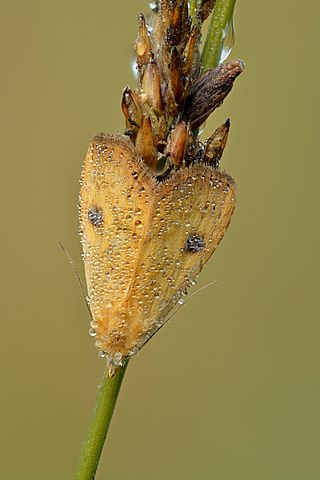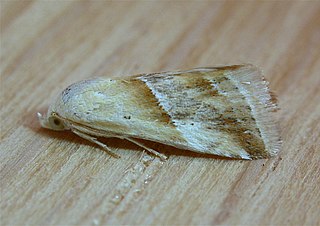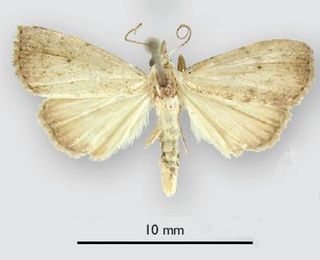
Rivula sericealis, the straw dot, is a moth of the family Noctuidae. The species was first described by Giovanni Antonio Scopoli in his 1763 Entomologia Carniolica. It is found in Europe including the Iberian Peninsula and southern Fennoscandia and south to North Africa. In an easterly direction, the species occurs across the Palearctic to the Pacific Ocean and Japan. The species closely resembles Evergestis forficalis.

Lymantria is a genus of tussock moths in the family Erebidae. They are widely distributed throughout Europe, Japan, India, Sri Lanka, Myanmar, Java, and Celebes. The genus was erected by Jacob Hübner in 1819.

Eublemma rivula is a species of moth of the family Erebidae first described by Frederic Moore in 1882. It is found in most of southeast Asia, including Hong Kong, India, Japan, the Society Islands, Taiwan and in Australia in the Australian Capital Territory, New South Wales and Queensland.

Carmara is a monotypic moth genus of the family Noctuidae. Its only species, Carmara subcervina, is found in Sri Lanka, Japan, Taiwan, Borneo and Australia. Both the genus and species were first described by Francis Walker in 1864.

Phytometra is a genus of moths of the family Erebidae. The genus was described by Adrian Hardy Haworth in 1809.

Rivula is a genus of moths in the family Erebidae described by Achille Guenée in 1845.
Thalatha is a genus of moths of the family Noctuidae. The genus was erected by Francis Walker in 1862.

Rivula stepheni is a species of moth of the family Erebidae first described by James Bolling Sullivan in 2009. It is found in the US in eastern North Carolina, Louisiana and Florida.

Rivula propinqualis, the spotted grass moth or yellow snout-moth, is a moth of the family Erebidae. The species was first described by Achille Guenée in 1854. It is found throughout eastern North America from southern Canada southward to Florida and Texas and westward in the north to British Columbia and Washington. In North Carolina it is found from the Appalachian Mountains to the Atlantic coast.
Rivula aenictopis is a moth of the family Erebidae first described by Alfred Jefferis Turner in 1908. It is found in northern Queensland, Australia.
Rivula biagi is a moth of the family Erebidae first described by George Thomas Bethune-Baker in 1908. It is known from New Guinea and the Australian state of Queensland.
Rivula concinna is a moth of the family Erebidae first described by Thomas Pennington Lucas in 1895. It lives in Australia in Queensland, Western Australia and the Northern Territory.
Rivula everta is a moth of the family Erebidae first described by Charles Swinhoe in 1901. It is found in Australia in Queensland and the Northern Territory.
Rivula niphodesma is a moth of the family Erebidae first described by Edward Meyrick in 1891. It is found in Australia in the Northern Territory and Queensland and Buru.

Scirpophaga praelata is a species of moth of the family Crambidae. It is found in most of Europe, Russia, Turkey, Iran, Syria, Lebanon, North Africa, Japan, Taiwan, China and Australia.

Collix ghosha is a moth in the family Geometridae. It was described by Francis Walker in 1862. It is found in the Indo-Australian tropics, from the Indian subregion, Sri Lanka to Queensland, Japan and New Caledonia.

Rivula aequalis is a moth of the family Erebidae first described by Francis Walker in 1863. It is found in Sri Lanka, the Indian subregion, Japan, Sundaland, the Philippines and Sulawesi.

Acropteris is a genus of moths of subfamily Microniinae of family Uraniidae. The genus was erected by Carl Geyer in 1832. The species of this genus are found in tropical Asia, Africa and Australia.











